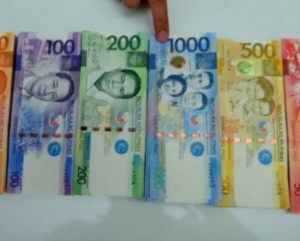
The country’s top monetary official, however, downplayed the peso’s weakness, noting that volatility in financial markets should be expected due to uncertainties over the US Federal Reserve’s policy direction.
The local currency closed at 45-to-$1 on Wednesday from 44.815:$1 the day before. This was the weakest close since Sept. 1, 2010—the last time the currency was at the 45:$1 level.
The peso opened weaker at 44.85 to $1, which was its strongest level for the day. The currency closed at its intraday low. Trading volume increased to $912.9 million from $771.10 million.
US retail sales rose by a stronger-than-expected 0.2 percent last month, government data released on Wednesday showed. This bolstered the expectation that the Fed would maintain or accelerate the pace of tapering its bond-buying program to allow interest rates to rise from their record lows.
The dollar’s strength also came after the release of a World Bank report that showed global economic growth accelerating for the first time since 2008, driven mainly by improving conditions in advanced economies.
“The movement of the peso is being influenced by a lot of factors. These would include the uncertainty about the speed and the duration of the Fed tapering,” Bangko Sentral ng Pilipinas (BSP) Governor Amando M. Tetangco Jr. said in an interview on Wednesday. “And then you also have still-remaining questions about the ability of Europe to achieve economic growth and continue with the financial sector reforms that they have started to implement.”
He said the “rebalancing” of the global economy due to better conditions in advanced markets like the United States has also prompted fund managers to re-evaluate their portfolios.
“The impact on investors is for them to review their portfolios and see if they have to also, from their point of view, rebalance their portfolios,” Tetangco said.
The inter-agency Development Budget Coordination Committee (DBCC), which sets the government’s official macroeconomic assumptions, expects the peso to average between 41 and 43 to a dollar this year, implying that the currency should strengthen from its current level later in the year.
Tetangco stressed that the Philippines’ macroeconomic fundamentals remained sound, citing the country’s robust balance-of-payments surplus and ample reserves—both supported by remittances from overseas Filipino workers.
He added that stable consumer prices and above-trend economic growth would also help protect the economy from external shocks.
“If you look at the region, our currency has not depreciated the most or appreciated the most. In terms of volatility, we are also in the middle,” he said.

